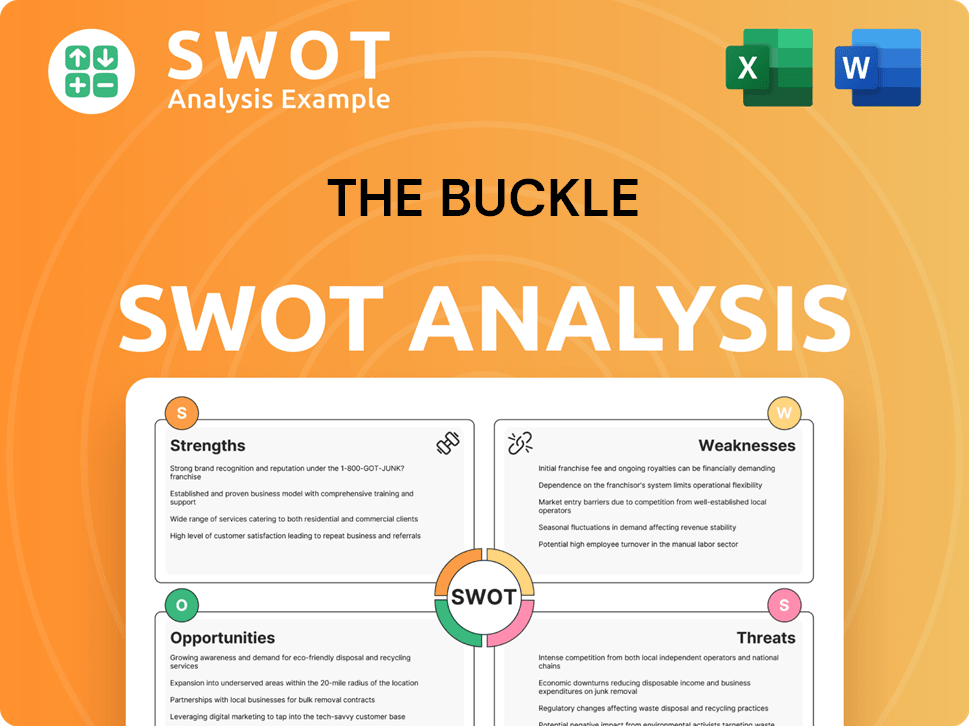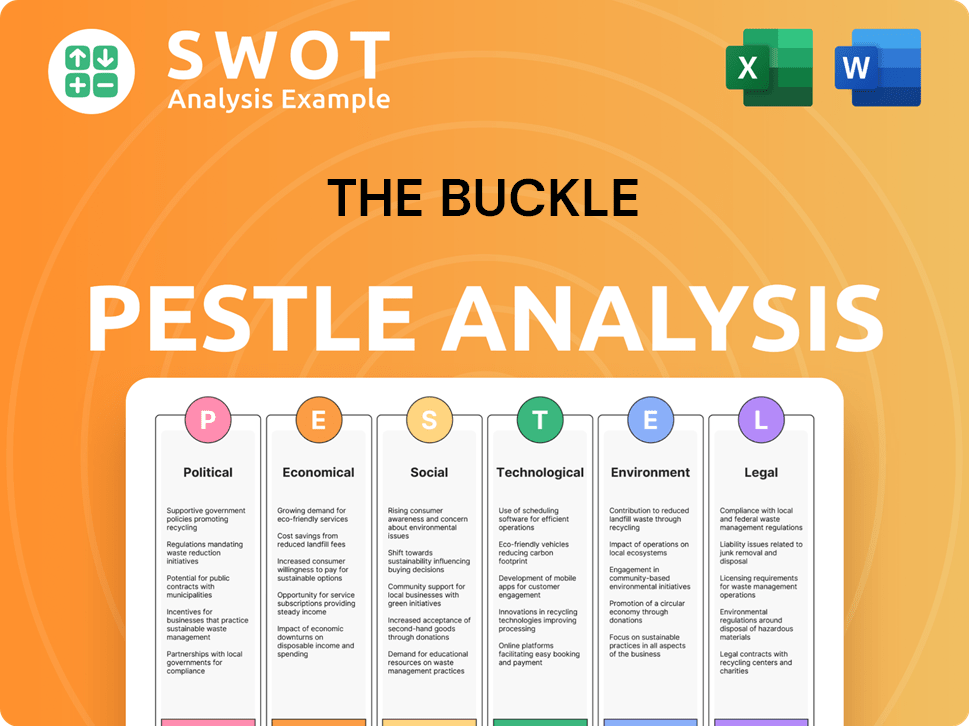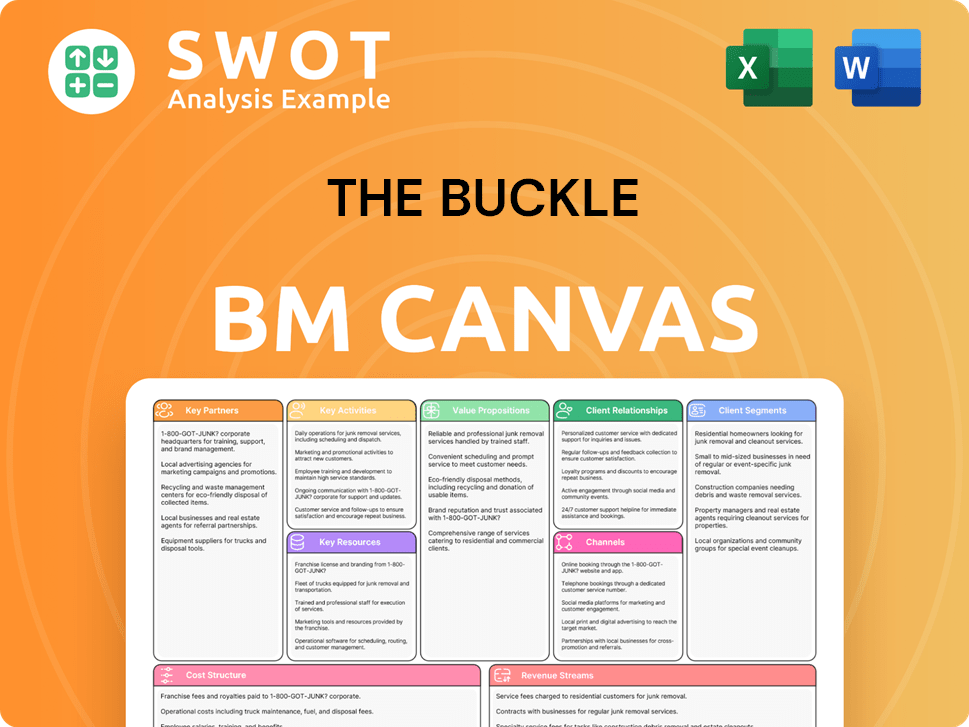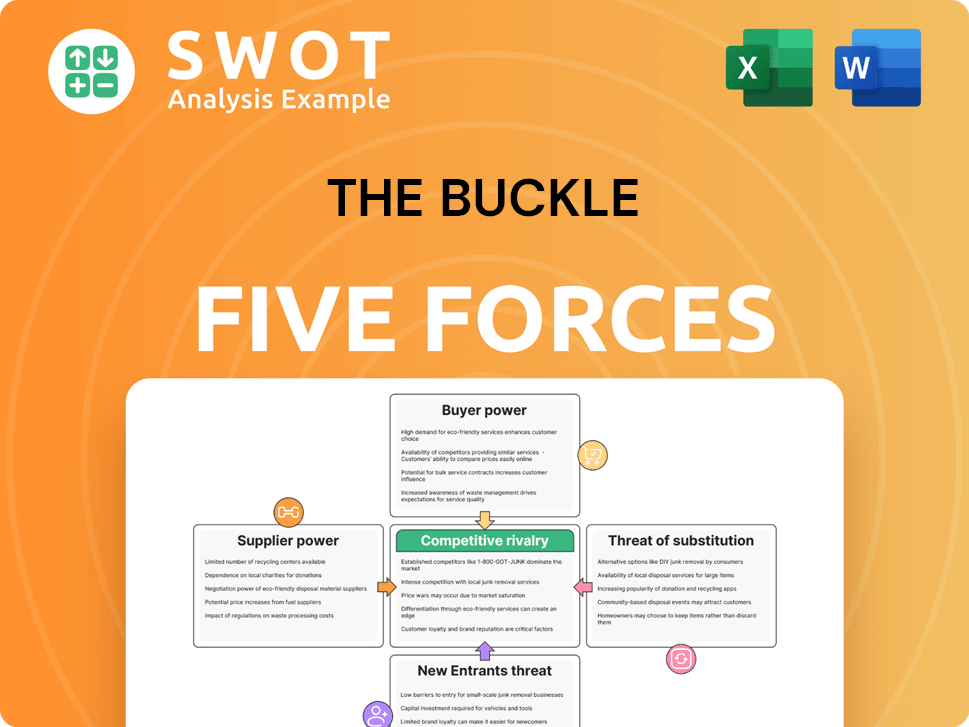The Buckle Bundle
Can The Buckle Company Thrive in Today's Retail Arena?
The retail world is a battlefield, where consumer tastes shift and competition is fierce. The Buckle Company, a name synonymous with fashion, has navigated this landscape for decades, evolving from a local store to a national retailer. Understanding its position within this dynamic environment is crucial for anyone interested in the future of retail.

This analysis will dissect The Buckle's competitive landscape, providing a detailed The Buckle SWOT Analysis to understand its strengths and weaknesses within the Buckle retail landscape. We'll explore the Buckle market position, examining its key Buckle competitors and the strategies it employs to maintain its relevance. Furthermore, we'll delve into the Buckle industry trends influencing its operations, offering insights into its Buckle competitive analysis and long-term growth potential.
Where Does The Buckle’ Stand in the Current Market?
The Buckle, Inc. focuses on the apparel, footwear, and accessories retail sector, specifically targeting young, fashion-conscious consumers. Its core operations center around curating a selection of denim, fashion tops, and other merchandise. This focus allows the company to maintain a distinct market position within the Buckle retail landscape.
The company's value proposition lies in offering contemporary and branded merchandise to its target demographic. The company's physical retail stores serve as key touchpoints for its target customer base. As of June 6, 2024, the company operated 440 retail stores across 42 states, demonstrating its significant operational scale.
The company's financial performance, as evidenced by its net sales figures, suggests a stable performance compared to industry averages. For the four-week period ended May 4, 2024, the company reported net sales of $96.9 million, and for the thirteen-week period ended May 4, 2024, net sales were $343.8 million. This financial health helps maintain its Buckle market position.
The company's geographical presence is primarily concentrated in the United States. With 440 stores across 42 states, The Buckle has a broad reach. This extensive network enables the company to effectively serve its target customer base.
The primary product lines include denim, fashion tops, and other apparel, footwear, and accessories. This curated selection caters to a demographic seeking contemporary and branded merchandise. The company has a strong focus on denim and casual wear.
The company has embraced digital transformation to enhance its e-commerce capabilities. This allows the company to complement its brick-and-mortar presence and cater to evolving consumer shopping habits. The company is working to improve its online sales strategy.
The Buckle competitive analysis reveals that the company faces competition from various retailers. Its position may be weaker in highly urbanized areas dominated by fast-fashion giants or luxury brands. Understanding the competitive landscape is key to maintaining its market position.
The company's strengths include a well-established brand, a focus on a specific niche, and a strong store network. The company's consistent revenue generation and widespread store presence indicate a strong, established position. For more insights, read about the Marketing Strategy of The Buckle.
- Consistent financial performance.
- Extensive retail store network.
- Focus on a specific target demographic.
- Adaptation to digital transformation.
The Buckle SWOT Analysis
- Complete SWOT Breakdown
- Fully Customizable
- Editable in Excel & Word
- Professional Formatting
- Investor-Ready Format

Who Are the Main Competitors Challenging The Buckle?
The retail apparel market is fiercely competitive, and The Buckle Company faces a diverse range of competitors. Understanding the competitive landscape is crucial for analyzing The Buckle's market position and future growth potential. This analysis considers both direct and indirect competitors, highlighting the challenges and opportunities within the Buckle industry.
The Buckle's competitive analysis involves assessing its position against key players in the retail landscape. This includes evaluating their market share, financial performance, and strategic initiatives. This analysis helps in understanding the dynamics of the apparel market.
The Buckle operates in a highly competitive retail apparel market, facing challenges from a diverse range of direct and indirect competitors. Its most significant direct competitors include other specialty apparel retailers that cater to a similar demographic and offer comparable product assortments, particularly in denim and casual wear. While specific competitor sales figures can fluctuate, key players include American Eagle Outfitters, known for its strong denim offerings and casual wear, and Abercrombie & Fitch, which has revitalized its brand to appeal to a broader young adult audience. Both companies leverage extensive store networks and robust e-commerce platforms, often engaging in price wars and aggressive marketing campaigns to capture market share.
Direct competitors are specialty apparel retailers that target a similar demographic and offer comparable products, especially in denim and casual wear. These competitors directly challenge The Buckle's market share and customer base. Analyzing these competitors is crucial for understanding the Buckle's competitive landscape.
American Eagle Outfitters is a significant direct competitor, known for its strong denim and casual wear offerings. They have a large store network and a robust e-commerce platform. American Eagle often engages in aggressive marketing campaigns to capture market share.
Abercrombie & Fitch has revitalized its brand to appeal to a broader young adult audience. They compete with The Buckle by offering similar products and leveraging extensive store networks. Abercrombie & Fitch also focuses on e-commerce.
Zumiez focuses on action sports-inspired apparel and footwear. Zumiez challenges The Buckle through its distinct brand identity and loyalty programs. This retailer presents a different niche within the apparel market.
Smaller regional boutiques offer a more curated or niche selection. These boutiques challenge The Buckle through their distinct brand identities and promotional strategies. They often focus on unique product offerings.
Indirect competition comes from a broader array of retailers, including department stores, fast-fashion retailers, and online-only retailers. These competitors offer diverse products and pricing strategies. Understanding indirect competitors is key for a comprehensive Buckle competitive analysis.
Indirect competition stems from a broader array of retailers, including large department stores such as Macy's and Nordstrom, which offer a wide variety of apparel brands, including some that overlap with The Buckle's offerings. Additionally, fast-fashion retailers like H&M and Zara pose a threat by rapidly introducing new trends at lower price points, appealing to budget-conscious consumers seeking immediate fashion gratification. The rise of online-only retailers, such as ASOS and Boohoo, also presents significant indirect competition, as they offer vast selections, competitive pricing, and convenient home delivery, often without the overhead of physical stores. The competitive landscape is further influenced by new and emerging direct-to-consumer (DTC) brands that leverage social media and influencer marketing to build strong brand communities and bypass traditional retail channels. The ongoing consolidation within the retail sector, including mergers and acquisitions, also reshapes competitive dynamics, potentially creating larger, more formidable rivals with expanded market reach and financial resources.
Several factors influence the competitive landscape for The Buckle. These factors include pricing strategies, marketing campaigns, and the ability to adapt to changing consumer trends. Analyzing these factors is crucial for understanding the Buckle's market position.
- Pricing Strategy: Competitors' pricing strategies significantly impact The Buckle's sales.
- Marketing Campaigns: Aggressive marketing campaigns by competitors can affect The Buckle's brand visibility.
- E-commerce Platforms: Robust e-commerce platforms are essential for competing in the online retail space.
- Customer Loyalty Programs: Loyalty programs help retain customers and build brand loyalty.
- Product Offerings: The variety and quality of product offerings are critical for attracting customers.
- Brand Positioning: A strong brand identity helps differentiate The Buckle from its competitors.
The Buckle PESTLE Analysis
- Covers All 6 PESTLE Categories
- No Research Needed – Save Hours of Work
- Built by Experts, Trusted by Consultants
- Instant Download, Ready to Use
- 100% Editable, Fully Customizable

What Gives The Buckle a Competitive Edge Over Its Rivals?
The competitive advantages of The Buckle Company, stem from a curated merchandise assortment, strong vendor relationships, and a distinctive in-store customer experience. This strategy has allowed the company to maintain a strong market position within the apparel retail landscape. The company's ability to offer a diverse mix of popular denim brands and fashion-forward apparel, footwear, and accessories, resonates with its target demographic.
The company's long-standing relationships with key vendors enable it to secure desirable inventory and potentially negotiate favorable terms, contributing to its product differentiation. The Buckle places a significant emphasis on its personalized customer service model within its physical stores, fostering customer loyalty and repeat business. This high-touch approach differentiates it from larger, more impersonal department stores or purely online retailers.
The company's strong brand equity, built over decades, also contributes to its competitive edge, fostering recognition and trust among its consumer base. The Buckle has strategically invested in its e-commerce platform to complement its brick-and-mortar presence, ensuring a seamless omnichannel experience for its customers. For more insights into the company's strategic direction, consider exploring the Growth Strategy of The Buckle.
The Buckle's ability to offer a diverse and continually refreshed mix of popular denim brands and fashion-forward apparel, footwear, and accessories is a key competitive advantage. This curated selection often includes exclusive styles or limited editions, creating a sense of uniqueness for its customers. This helps differentiate The Buckle from competitors in the Buckle retail landscape.
The company's long-standing relationships with key vendors enable it to secure desirable inventory and potentially negotiate favorable terms. These relationships contribute significantly to its product differentiation. This advantage is crucial in maintaining a competitive edge in the Buckle industry.
The personalized customer service model within its physical stores is a significant differentiator. Sales associates are often trained to provide styling advice and foster a welcoming shopping environment, which contributes to customer loyalty and repeat business. This high-touch approach sets it apart from larger retailers.
The company's strong brand equity, built over decades, fosters recognition and trust. The investment in an e-commerce platform to complement its brick-and-mortar presence ensures a seamless omnichannel experience. This integration allows customers to browse online, purchase in-store, or vice versa.
The Buckle's competitive advantages are primarily centered around its curated merchandise, strong vendor relationships, and a distinctive in-store customer experience. These factors contribute to the company's strong brand equity and market position. However, the fast-paced fashion industry requires continuous adaptation.
- Curated Merchandise: Offers a diverse mix of denim, apparel, footwear, and accessories.
- Strong Vendor Relationships: Secures desirable inventory and favorable terms.
- Personalized Customer Service: Provides styling advice and a welcoming environment.
- Omnichannel Strategy: Integrates online and in-store experiences.
The Buckle Business Model Canvas
- Complete 9-Block Business Model Canvas
- Effortlessly Communicate Your Business Strategy
- Investor-Ready BMC Format
- 100% Editable and Customizable
- Clear and Structured Layout

What Industry Trends Are Reshaping The Buckle’s Competitive Landscape?
Understanding the retail landscape is crucial for assessing The Buckle's position, risks, and future outlook. The apparel industry is dynamic, shaped by technological advancements, shifting consumer preferences, and economic conditions. These factors necessitate a proactive approach to maintain a competitive edge. A Brief History of The Buckle reveals how the company has adapted to past challenges, offering insights into its potential to navigate future ones.
The company faces both challenges and opportunities. Economic fluctuations, changing consumer behaviors, and the rise of e-commerce require strategic agility. Success will depend on its ability to adapt to these changes and leverage its strengths.
The retail apparel industry is undergoing significant transformation. Technological advancements, particularly in e-commerce and data analytics, are reshaping consumer shopping habits. The demand for omnichannel experiences and personalized marketing is increasing.
Challenges include the continued rise of AI in retail and market fragmentation. Declining demand for traditional retail experiences and increased regulation pose threats. Aggressive new competitors with lower operating costs are also a concern.
Opportunities exist in emerging markets and product innovation. Strategic partnerships and the company's established brand provide a strong foundation. Leveraging data analytics to personalize the customer experience is vital.
Enhancing omnichannel capabilities and optimizing merchandise are key. Data analytics will be crucial for personalizing the customer experience. Adapting to external forces and differentiating itself in the market will be essential.
The company must address the evolving retail landscape to maintain its Buckle market position. Understanding Buckle's competitive analysis and the broader Buckle industry is vital for sustained success. Adapting to consumer preferences and technological advancements is crucial for future growth.
- E-commerce Integration: Investing in a robust online platform and seamless omnichannel experiences. In 2024, e-commerce sales are projected to constitute around 20% of total retail sales in the apparel sector.
- Data Analytics: Utilizing data to personalize marketing and improve inventory management. Data analytics can improve inventory turnover by up to 15%.
- Sustainability and Ethical Sourcing: Aligning with consumer preferences for sustainable practices. The sustainable apparel market is expected to reach $9.81 billion by 2025.
- Strategic Partnerships: Collaborating with complementary brands or influencers to expand reach. Partnerships can increase brand awareness by up to 30%.
The Buckle Porter's Five Forces Analysis
- Covers All 5 Competitive Forces in Detail
- Structured for Consultants, Students, and Founders
- 100% Editable in Microsoft Word & Excel
- Instant Digital Download – Use Immediately
- Compatible with Mac & PC – Fully Unlocked

Related Blogs
- What are Mission Vision & Core Values of The Buckle Company?
- What is Growth Strategy and Future Prospects of The Buckle Company?
- How Does The Buckle Company Work?
- What is Sales and Marketing Strategy of The Buckle Company?
- What is Brief History of The Buckle Company?
- Who Owns The Buckle Company?
- What is Customer Demographics and Target Market of The Buckle Company?
Disclaimer
All information, articles, and product details provided on this website are for general informational and educational purposes only. We do not claim any ownership over, nor do we intend to infringe upon, any trademarks, copyrights, logos, brand names, or other intellectual property mentioned or depicted on this site. Such intellectual property remains the property of its respective owners, and any references here are made solely for identification or informational purposes, without implying any affiliation, endorsement, or partnership.
We make no representations or warranties, express or implied, regarding the accuracy, completeness, or suitability of any content or products presented. Nothing on this website should be construed as legal, tax, investment, financial, medical, or other professional advice. In addition, no part of this site—including articles or product references—constitutes a solicitation, recommendation, endorsement, advertisement, or offer to buy or sell any securities, franchises, or other financial instruments, particularly in jurisdictions where such activity would be unlawful.
All content is of a general nature and may not address the specific circumstances of any individual or entity. It is not a substitute for professional advice or services. Any actions you take based on the information provided here are strictly at your own risk. You accept full responsibility for any decisions or outcomes arising from your use of this website and agree to release us from any liability in connection with your use of, or reliance upon, the content or products found herein.